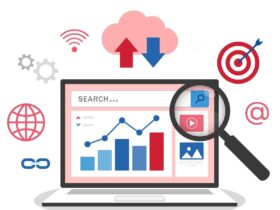In today’s competitive business landscape, data plays a crucial role in decision-making, especially in marketing. To communicate complex marketing analytics effectively, professionals need powerful tools that help them create visually appealing and easy-to-understand presentations. Two of the most popular tools for creating marketing presentations are Canva and Adobe Spark. Both platforms offer simple-to-use interfaces and robust features, but choosing between them can be tricky, particularly for professionals who have completed a business analysis course or a BA analyst course and are looking for the right tool to present data insights clearly.
In this article, we will compare Canva and Adobe Spark, focusing on their features, ease of use, customization capabilities, and pricing to help you decide which platform is best suited for creating marketing analytics presentations. Whether you are a professional in business analysis or a student in a BA analyst course, understanding how these tools differ will help you select the right one for your presentation needs.
What is Canva?
Canva is an online graphic design platform that lets you create a wide range of visuals, including presentations, social media posts, posters, and more. Known for its user-friendly interface, Canva has quickly become the go-to tool for both pros and beginners looking to create polished designs without any prior graphic design experience. Canva’s drag-and-drop functionality, coupled with its extensive library of templates, images, icons, and fonts, makes it an excellent choice for creating visually engaging marketing analytics presentations.
For students taking a business analyst course, Canva is a valuable tool for turning raw data into compelling visual presentations that can effectively communicate key insights to stakeholders. Canva simplifies the process of creating data visualizations, making it ideal for users who may not have extensive design experience but need to present data in a clear, professional manner.
What is Adobe Spark?
Adobe Spark is another popular graphic design tool that focuses on creating web pages, graphics, and video stories. Developed by Adobe, Spark is part of the Creative Cloud suite and provides a variety of templates and design elements that assist users in creating professional-looking presentations quickly. Adobe Spark, like Canva, is designed with ease of use in mind, making it accessible to non-designers. It offers various tools for creating dynamic marketing presentations that can include multimedia elements such as videos, images, and animations.
For those enrolled in a BA analyst course, Adobe Spark is a fantastic platform to learn how to create presentations that combine data with compelling visuals. Adobe Spark’s strength lies in its ability to integrate multimedia elements seamlessly into presentations, making it an excellent option for dynamic marketing analytics presentations that go beyond static slides.
User Interface and Ease of Use: Canva vs Adobe Spark
Canva Ease of Use
One of Canva’s biggest advantages is its intuitive and user-friendly interface. It is designed for people with little to no design experience, allowing users to create stunning presentations through its drag-and-drop feature. Canva has a large range of templates tailored exclusively to marketing, making it simple to create data-driven presentations. It also includes a variety of data visualization tools, such as charts, graphs, and infographics, which are required for presenting marketing analytics.
For students in a business analyst course, Canva’s ease of use makes it a great tool for creating professional presentations in a short amount of time. The platform’s interface is simple enough to allow users to focus on the data they want to present, rather than getting bogged down by complicated design tools.
Adobe Spark Ease of Use
Adobe Spark is also known for its simplicity, but it focuses more on storytelling. The user interface is clean and modern, with numerous layouts that can be readily customized. Adobe Spark’s design philosophy emphasizes the creation of visual narratives, which can be particularly effective in marketing presentations where storytelling is key. While Spark is easy to use, it offers fewer data-specific design elements like charts and graphs compared to Canva.
For students or professionals who have completed a BA analyst course, Adobe Spark is ideal for creating presentations that integrate videos, images, and animations to tell a more engaging story. However, users may find Spark’s limitations in data visualization a drawback when dealing with in-depth marketing analytics presentations.
Customization and Design Flexibility: Canva vs Adobe Spark
Canva Customization
Canva offers extensive customization options, allowing users to tweak templates to fit their brand’s aesthetic or specific presentation needs. Users can choose from hundreds of fonts, icons, images, and color schemes. Canva also allows customers to add their own logos and images, which is critical for maintaining consistent branding in marketing presentations.
For those enrolled in a business analyst course, Canva’s flexibility in customization makes it a great platform for creating presentations that are tailored to specific business needs. The ability to easily create infographics and visually represent data trends is a significant advantage for professionals in business analysis who need to convey complex data in a simplified manner.
Adobe Spark Customization
Adobe Spark also allows for customization, but its focus is more on creating visual stories rather than data-specific presentations. Spark excels in adding multimedia elements, such as videos and animated transitions, that can make a presentation more dynamic and engaging. However, its limitations in data visualization tools, like built-in graphs or detailed infographics, make it less suited for data-heavy marketing analytics presentations.
For professionals or students in a BA analyst course, Adobe Spark’s customization options are perfect for creating visually stunning presentations that include multimedia, but it may fall short when it comes to visualizing complex data in charts or graphs.
Data Visualization and Analytics Presentation: Canva vs Adobe Spark
Canva for Data Visualization
One of Canva’s strengths is its ability to create effective data visualizations. Canva offers a range of tools that help users design charts, graphs, and infographics, making it easier to translate raw marketing analytics data into a format that is easily understandable for stakeholders. Canva’s ready-made templates for charts and diagrams allow users to create data-driven visuals without the need for advanced design skills.
For students in a business analyst course, Canva’s data visualization capabilities are invaluable for presenting data trends, consumer behavior insights, and performance metrics in marketing analytics presentations. Canva makes it simple to highlight key data points and create presentations that are not only visually appealing but also informative.
Adobe Spark for Data Visualization
Adobe Spark is more focused on storytelling and is not as equipped for detailed data visualization as Canva. While Adobe Spark allows users to insert images, videos, and other media into presentations, it lacks the advanced charting and infographic tools that Canva offers. As a result, it may not be the best tool for professionals who need to present detailed marketing analytics data in the form of charts or tables.
For professionals or students in a BA analyst course, Adobe Spark is better suited for presentations that require high-impact visuals and multimedia but not for in-depth analysis or data visualization. If your presentation focuses on qualitative rather than quantitative data, Adobe Spark may be a more suitable option.
Collaboration and Sharing: Canva vs Adobe Spark
Canva Collaboration Features
Canva offers several collaboration features that allow teams to work together on a presentation. Users can share designs with team members, who can then edit or comment on the presentation in real time. Canva also allows for version history tracking, so teams can review previous versions of their work. This feature is especially useful in a marketing team setting, where multiple stakeholders need to collaborate on a single presentation.
For students or professionals in a business analyst course, Canva’s collaboration features are a huge advantage when working on group projects, as it enables seamless teamwork and real-time feedback.
Adobe Spark Collaboration Features
Adobe Spark also offers collaboration options, but they are more limited compared to Canva. While users can share their projects with others, the collaborative features are not as robust as Canva’s. Adobe Spark focuses more on creating individual projects that can be shared, rather than encouraging collaborative editing and feedback.
For those in a BA analyst course, Adobe Spark’s limited collaboration features may be a drawback, particularly when working in team environments where multiple edits and real-time feedback are necessary.
Pricing: Canva vs Adobe Spark
Canva Pricing
Canva offers a free version with basic features, which is sufficient for creating simple marketing presentations. For more advanced features, including premium templates and additional customization options, Canva offers a Pro plan, which is competitively priced. Canva’s Pro plan includes access to millions of stock images, advanced data visualization tools, and brand kits.
For students in a business analyst course, Canva’s free version provides an excellent entry point into design, while the Pro plan offers additional features that can be useful for more advanced presentations.
Adobe Spark Pricing
Adobe Spark also offers a free version, but with limited customization and branding options. For more advanced features, Adobe Spark’s premium plan provides access to custom branding, additional templates, and the ability to create more complex designs. However, compared to Canva, Adobe Spark’s free version is more restricted in terms of features.
For professionals or students in a BA analyst course, Adobe Spark’s premium plan may be necessary if you require more branding and design flexibility, but it comes at a slightly higher cost than Canva’s Pro plan.
Conclusion: Which is Better for Creating Marketing Analytics Presentations?
When comparing Canva and Adobe Spark for creating marketing analytics presentations, the choice ultimately depends on your specific needs. Canva excels in data visualization, making it the better option for professionals who need to present complex data insights, trends, and analytics. Its easy-to-use interface, along with its extensive customization and collaboration features, make it ideal for students and professionals in a business analyst course who need to present data-driven insights clearly and effectively.
On the other hand, Adobe Spark is a fantastic choice for creating dynamic presentations that focus on storytelling and multimedia elements. While it falls short in data visualization compared to Canva, it is a great tool for presentations that require high-quality visuals, animations, and videos. For professionals or students in a BA analyst course who need to create visually compelling narratives, Adobe Spark may be the right choice.
Ultimately, the decision between Canva and Adobe Spark will depend on whether you prioritize data visualization or storytelling in your marketing analytics presentations.
Business Name: ExcelR- Data Science, Data Analytics, Business Analyst Course Training Mumbai
Address: Unit no. 302, 03rd Floor, Ashok Premises, Old Nagardas Rd, Nicolas Wadi Rd, Mogra Village, Gundavali Gaothan, Andheri E, Mumbai, Maharashtra 400069, Phone: 09108238354, Email: enquiry@excelr.com.












